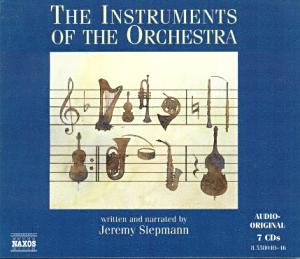Curio Corner
The Instruments of the Orchestra
Written and narrated Jeremy Siepmann
NAXOS 558040-16 7 CDs and 208 page book [just over 8 hrs music and narration]

What a splendid idea this is. For music students of all ages, lecturers (it's an ideal teaching tool), for the general music lover who wants to increase his knowledge, and (dare I say it) as a memory aide for composers, arrangers and orchestrators, this is a marvellous in-depth appreciation of the capabilities and usage of The Instruments of the Orchestra. Jeremy Siepmann, the author and narrator, born in America, but for long resident in the U.K., is a classical music journalist and reviewer, broadcaster (he was appointed Head of Music at a BBC World Service). He is therefore an ideal choice.
Siepmann uses many, many excerpts from Naxos's huge catalogue to demonstrate the compass of the instruments of the orchestra and the way composers have used them to convey drama, atmosphere and a wide variety of emotions. The booklet includes a written version of his narration as well as full details of the excerpts.
The first CD is devoted entirely to the violin, the backbone of every conventional orchestra. "The violin is amongst the most versatile and expressive instruments ever conceived…" Amongst the many examples, Siepmann uses are: the Adagio slow movement of the Brahms Violin Concerto to illustrate its tender voice, 'The Triumphal March of the Devil' from Stravinsky's The Soldier's Tale to illustrate its earlier devilish reputation and Csárdás Music to illustrate fiery, passionate gypsy violin music. Violin playing techniques like tremolando, pizzicato and double stopping are covered too; and the use of the mute to give a quieter more intimate sound.
The other CDs, again with many examples, cover the lower strings, woodwind, the brass, percussion and, intriguingly, an extra session amusingly entitled 'Interlopers' (CD6) that includes - the keyboards: organ, piano and harpsichord; plus more exotic fare like: sleighbells (Mahler Symphony No. 4 opening) and cowbells (Mahler Symphony No. 6 'Tragic' 1st movement). Then there is the typewriter (Leroy Anderson's The Typewriter) sandpaper (Leroy Anderson's Sandpaper Ballet) and wind machine (Vaughan Williams Symphony No. 7 'Sinfonia Antarctica') – and many more.
As can be imagined this is a pleasing and wide-ranging adventure in learning music: entertaining and amusing as much as instructive. To appreciate a little more its wide scope, it is worth looking at the contents:-
Historical profiles of the major instruments. This is a major feature covering 36 pages. It is divided into the main sections of the orchestra commencing with detailed histories of the developments of the strings: violin, viola, cello and double bass. Then come the woodwinds: flute, piccolo, oboe, the clarinet family (soprano, alto bass and contra-bass), saxophone, bassoon and contra-bassoon. The brass: trumpet, trombone, French horn, and tuba, and percussion: triangle, celeste, tambourine, bongo drums, tubular bells, side drum, bass drum, kettledrums, the xylophone family (xylophone, glockenspiel, marimba, and vibraphone), and the harp. Line illustrations of each instrument are included.
The greatest instrument makers. This short section covers the most famous instrument craftsman such as Antonio Stradivari and Adolphe Sax.
Instrument typecasting Here Siepmann shows how instruments are frequently typecast into conveying specific emotions and asserts that they are often more versatile. For example :–
Violin – Romantic, lyrical, sensuous, seductive, virtuosic, versatile but also in the seventeenth century and earlier, devilish, vulgar and frivolous.
References to examples on the accompanying CDs are included.The art of orchestration and transcription
The original instrument debate
Orchestral seating plan (arrangement of the orchestra on the platform) including "Why have some conductors, past and present, chosen alternative arrangements – and with what results"
Size and constitution of the orchestra (difference between a chamber ensemble and an orchestra, and really big orchestras)
Recommended reading
A pleasing and wide-ranging adventure in learning music: entertaining and amusing as well as instructive.
Ian Lace

Return to Index